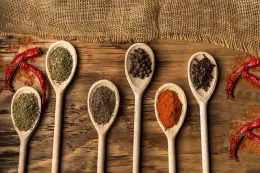
By Annette Smith, UCCE Master Food Preserver
From the Master Food Preserver Help desk comes a common question:
What are important points I need to know about drying home-grown herbs?
Drying herbs is a great way to preserve the flavor and aroma of your garden year-round. Dried herbs take up less storage space and can be stored at room temperature at minimal cost. However, for longer shelf life, storing dried herbs in a refrigerator or freezer is recommended.
Methods of Drying Herbs:
• Dehydrators:
Offer the best quality dried products. Look for a dehydrator with a heat source, thermostat, and good air circulation.
• Oven Drying:
Takes 2 to 3 times longer than a dehydrator. Use a temperature between 130°F and 150°F. If the oven is too hot, herbs may begin to cook rather than dry. Keep the door propped open to allow air circulation.
• Convection Oven Drying:
Convection ovens with built-in fans can be used if they can maintain the low drying temperatures required (130°F to 150°F).
• Microwave Drying:
Only herbs should be dried in a microwave. Monitor closely, as herbs can catch fire if over-dried. Do not dry fruits, vegetables, or meats in a microwave.
• Air Drying:
Small bundles of herb stems can be hung to dry in a warm, dry, and well-ventilated area.
Preparing Herbs for Drying:
• Start with clean hands, countertops, and utensils.
• Remove any bruised, soiled, or imperfect leaves and stems.
• Rinse the stems in cool water and gently shake off excess moisture.
• Pat dry with a paper towel or use a salad spinner to remove as much moisture as possible.
Testing for Dryness:
Herbs are fully dry when the leaves are crisp and crumble easily between your fingers. This helps prevent mold growth during storage.
Treating Air-Dried Herbs and Seeds:
To eliminate any insects or eggs:
• Heat herbs at 160°F (71°C) for 30 minutes (Note: this may reduce flavor and is not recommended for seeds you intend to plant).
• Alternatively, freeze at 0°F (-17°C) or lower for at least 48 hours.
Storing Dried Herbs:
• Use airtight, vapor-proof containers to prevent herbs from absorbing moisture or losing aroma.
• Store in a cool, dry, and dark place—avoid placing them near stoves or on windowsills.
• While refrigeration or freezing can extend freshness, it may lead to condensation when containers are returned to room temperature. To avoid odor transfer, use freezer jars or heavy-duty aluminum foil.
Dried herbs typically retain good quality for up to a year. Whole herbs hold flavor longer than crushed or ground versions. Test potency by their aroma before use.
Substituting Dried Herbs for Fresh:
Use the following guidelines:
• 1 tablespoon fresh herb
• 1 teaspoon dried herb
• 1/4 teaspoon powdered herb
Image Credit: Image by Matej Madar from Pixabay
Additional References:
· Iowa State University Extension – Growing, Harvesting, and Drying Herbs
· Wisconsin Master Gardener – Drying Herbs
· PennState Extension – Let’s Preserve: Drying Herbs
· UC Master Gardeners Sonoma County – Drying Herbs
